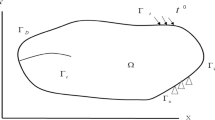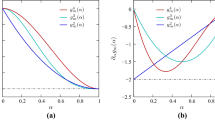Abstract
Failure analyses of piezoelectric structures and devices are of engineering and scientific significance. In this paper, a fourth-order phase-field fracture model for piezoelectric solids is developed based on the Hamilton principle. Three typical electric boundary conditions are involved in the present model to characterize the fracture behaviors in various physical situations. A staggered algorithm is used to simulate the crack propagation. The polynomial splines over hierarchical T-meshes (PHT-splines) are adopted as the basis function, which owns the C1 continuity. Systematic numerical simulations are performed to study the influence of the electric boundary conditions and the applied electric field on the fracture behaviors of piezoelectric materials. The electric boundary conditions may influence crack paths and fracture loads significantly. The present research may be helpful for the reliability evaluation of the piezoelectric structure in the future applications.
Similar content being viewed by others
References
GAO, C. F. and FAN, W. X. Exact solutions for the plane problem in piezoelectric materials with an elliptic or a crack. International Journal of Solids and Structures, 36, 2527–2540 (1999)
CHEN, W. Q. and DING, H. J. A penny-shaped crack in a transversely isotropic piezoelectric solid: modes II and III problems. Acta Mechanica Sinica, 15, 52–58 (1999)
WANG, B. L. and NODA, N. Exact thermoelectroelasticity solution for a penny-shaped crack in piezoelectric materials. Journal of Thermal Stresses, 27, 241–251 (2004)
ZHOU, Z. G. and CHEN, Z. T. A 3-D rectangular permeable crack or two 3-D rectangular permeable cracks in a piezoelectric material. Archive of Applied Mechanics, 81, 641–668 (2011)
CHEN, H., WEI, W., LIU, J., and FANG, D. Propagation of a semi-infinite conducting crack in piezoelectric materials: mode-I problem. Journal of the Mechanics and Physics of Solids, 68, 77–92 (2014)
BHARGAVA, R. R. and SHARMA, K. A study of finite size effects on cracked 2-D piezoelectric media using extended finite element method. Computational Materials Science, 50, 1834–1845 (2011)
MISHRA, R. and BURELA, R. G. Thermo-electro-mechanical fatigue crack growth simulation in piezoelectric solids using XFEM approach. Theoretical and Applied Fracture Mechanics, 104, 102388 (2019)
SCHLÜTER, A., WILLENBÜCHER, A., KUHN, C., and MÜLLER, R. Phase field approximation of dynamic brittle fracture. Computational Mechanics, 54, 1141–1161 (2014)
RABCZUK, T. and BELYTSCHKO, T. Cracking particles: a simplified meshfree method for arbitrary evolving cracks. International Journal for Numerical Methods in Engineering, 61, 2316–2343 (2004)
RABCZUK, T. and BELYTSCHKO, T. A three-dimensional large deformation meshfree method for arbitrary evolving cracks. Computer Methods in Applied Mechanics and Engineering, 196, 2777–2799 (2007)
RABCZUK, T., ZI, G., BORDAS, S., and HUNG, N. A simple and robust three-dimensional cracking-particle method without enrichment. Computer Methods in Applied Mechanics and Engineering, 199, 2437–2455 (2010)
FRANCFORT, G. A. and MARIGO, J. J. Revisiting brittle fracture as an energy minimization problem. Journal of the Mechanics and Physics of Solids, 46, 1319–1342 (1998)
BOURDIN, B., FRANCFORT, G. A., and MARIGO, J. J. Numerical experiments in revisited brittle fracture. Journal of the Mechanics and Physics of Solids, 48, 797–826 (2000)
MIEHE, C., WELSCHINGER, F., and HOFACKER, M. Thermodynamically consistent phase-field models of fracture: variational principles and multi-field FE implementations. International Journal for Numerical Methods in Engineering, 83, 1273–1311 (2010)
KUHN, C. and MÜLLER, R. A continuum phase field model for fracture. Engineering Fracture Mechanics, 77, 3625–3634 (2010)
PHAM, K., AMOR, H., MARIGO, J., and MAURINI, C. Gradient damage models and their use to approximate brittle fracture. International Journal of Damage Mechanic, 20, 618 (2011)
WU, J. Y. A unified phase-field theory for the mechanics of damage and quasi-brittle failure. Journal of the Mechanics and Physics of Solids, 103, 72–99 (2017)
WU, J. Y. and NGUYEN, V. A length scale insensitive phase-field damage model for brittle fracture. Journal of the Mechanics and Physics of Solids, 119, 20–42 (2018)
ZHOU, S., RABCZUK, T., and ZHUANG, X. Phase field modeling of quasi-static and dynamic crack propagation: COMSOL implementation and case studies. Advances in Engineering Software, 122, 31–49 (2018)
AMBATI, M., KRUSE, R., and DE LORENZIS, L. A phase-field model for ductile fracture at finite strains and its experimental verification. Computational Mechanics, 57, 149–167 (2016)
RODRIGUEZ, P., ULLOA, J., SAMANIEGO, C., and SAMANIEGO, E. A variational approach to the phase field modeling of brittle and ductile fracture. International Journal of Mechanical Sciences, 144, 502 (2018)
KHALIL, Z., ELGHAZOULI, A. Y., and MARTÍNEZ-PAÑEDA, E. A generalised phase field model for fatigue crack growth in elastic-plastic solids with an efficient monolithic solver. Computer Methods in Applied Mechanics and Engineering, 388, 114286 (2022)
HAO, S., CHEN, Y., CHENG, J., and SHEN, Y. A phase field model for high-speed impact based on the updated Lagrangian formulation. Finite Elements in Analysis and Design, 199, 103652 (2022)
DU, C., CUI, H., ZHANG, H., CAI, Z., and ZHAI, W. Phase field modeling of thermal fatigue crack growth in elastoplastic solids and experimental verification. Mechanics of Materials 188, 104839 (2024)
ZHOU, S., ZHUANG, X., and RABCZUK, T. A phase-field modeling approach of fracture propagation in poroelastic media. Engineering Geology, 240, 189–203 (2018)
ZHANG, Y., WANG, J., and ZHANG, T. The jumping dielectric breakdown behavior induced by crack propagation in ferroelectric materials: a phase field study. Journal of the Mechanics and Physics of Solids, 169, 105088 (2022)
YE, J. and ZHANG, L. Damage evolution of polymer-matrix multiphase composites under coupled moisture effects. Computer Methods in Applied Mechanics and Engineering, 388, 114213 (2022)
LI, D., LI, P., LI, W., and ZHOU, K. Three-dimensional phase-field modeling of temperature-dependent thermal shock-induced fracture in ceramic materials. Engineering Fracture Mechanics, 268, 108444 (2022)
TAN, Y., LIU, C., ZHAO, J., HE, Y., LI, P., and LI, X. Phase field model for brittle fracture in multiferroic materials. Computer Methods in Applied Mechanics and Engineering, 414, 116193 (2023)
MIEHE, C., WELSCHINGER, F., and HOFACKER, M. A phase field model of electromechanical fracture. Journal of the Mechanics and Physics of Solids, 58, 1716–1740 (2010)
ABDOLLAHI, A. and ARIAS, I. Phase-field modeling of crack propagation in piezoelectric and ferroelectric materials with different electromechanical crack conditions. Journal of the Mechanics and Physics of Solids, 60, 2100–2126 (2012)
WILSON, Z. A., BORDEN, M. J., and LANDIS, C. M. A phase-field model for fracture in piezoelectric ceramics. International Journal of Fracture, 183, 135–153 (2013)
MOHANTY, S., KUMBHAR, P. Y., SWAMINATHAN, N., and ANNABATTULA, R. A phase-field model for crack growth in electro-mechanically coupled functionally graded piezo ceramics. Smart Materials and Structures, 29, 045005 (2020)
WU, J. Y. and CHEN, W. X. Phase-field modeling of electromechanical fracture in piezoelectric solids: analytical results and numerical simulations. Computer Methods in Applied Mechanics and Engineering, 387, 114125 (2021)
TAN, Y., HE, Y., LIU, C., and LI, X. Phase field fracture model of transversely isotropic piezoelectric materials with thermal effect. Engineering Fracture Mechanics, 268, 108479 (2022)
TAN, Y., HE, Y., and LI, X. Phase field fracture modeling of transversely isotropic piezoelectric material with anisotropic fracture toughness. International Journal of Solids and Structures, 248, 111615 (2022)
TAN, Y., HE, Y., LI, X., and KANG, G. A phase field model for fatigue fracture in piezoelectric solids: a residual controlled staggered scheme. Computer Methods in Applied Mechanics and Engineering, 399, 115459 (2022)
DAN, S., TARAFDER, P., and GHOSH, S. Adaptive wavelet-enhanced cohesive zone phase-field FE model for crack evolution in piezoelectric composites. Computer Methods in Applied Mechanics and Engineering, 392, 114636 (2022)
TARAFDER, P., DAN, S., and GHOSH, S. Cohesive zone phase field model for electromechanical fracture in multiphase piezoelectric composites. Journal of Composite Materials, 57, 531–543 (2023)
BEHERA, A. K., UNNIKRISHNA PILLAI, A., and RAHAMAN, M. M. A phase-field model for electro-mechanical fracture with an open-source implementation of it using Gridap in Julia. Mathematics and Mechanics of Solids, 28, 1877–1908 (2023)
KIRAN, R., NGUYEN-THANH, N., and ZHOU, K. Adaptive isogeometric analysis-based phase-field modeling of brittle electromechanical fracture in piezoceramics. Engineering Fracture Mechanics, 274, 108738 (2022)
KIRAN, R., NGUYEN-THANH, N., YU, H., and ZHOU, K. Adaptive isogeometric analysis-based phase-field modeling of interfacial fracture in piezoelectric composites. Engineering Fracture Mechanics, 288, 10918 (2023)
BORDEN, M. J., HUGHES, T. J. R., LANDIS, C. M., and VERHOOSEL, C. V. A higher-order phase-field model for brittle fracture: formulation and analysis within the isogeometric analysis framework. Computer Methods in Applied Mechanics and Engineering, 273, 100 (2014)
GOSWAMI, S., ANITESCU, C., and RABCZUK, T. Adaptive fourth-order phase field analysis for brittle fracture. Computer Methods in Applied Mechanics and Engineering, 361, 112808 (2020)
MAKVANDI, R., DUCZEK, S., and JUHRE, D. A phase-field fracture model based on strain gradient elasticity. Engineering Fracture Mechanics, 220, 106648 (2020)
CHEN, L., LI, B., and DE-BORST, R. Adaptive isogeometric analysis for phase-field modeling of anisotropic brittle fracture. International Journal for Numerical Methods in Engineering, 121, 4630 (2020)
NGUYEN-THANH, N., LI, W., HUANG, J., and ZHOU, K. Adaptive higher-order phase-field modeling of anisotropic brittle fracture in 3D polycrystalline materials. Computer Methods in Applied Mechanics and Engineering, 372, 113434 (2020)
GOSWAMI, S., ANITESCU, C., and RABCZUK, T. Adaptive fourth-order phase field analysis using deep energy minimization. Theoretical and Applied Fracture Mechanics, 107, 102527 (2020)
SRIDHAR, A. and KEIP, M. A. A phase-field model for anisotropic brittle fracturing of piezoelectric ceramics. International Journal of Fracture, 220, 221–242 (2019)
PARK, S. and SUN, C. T. Fracture criteria for piezoelectric ceramics. Journal of the American Ceramic Society, 78, 1475–1480 (1995)
Author information
Authors and Affiliations
Corresponding author
Ethics declarations
Conflict of interest The authors declare no conflict of interest.
Additional information
Project supported by the National Natural Science Foundation of China (Nos. 12072297 and 12202370) and the Natural Science Foundation of Sichuan Province of China (No. 24NSFSC4777)
Rights and permissions
About this article
Cite this article
Tan, Y., Peng, F., Liu, C. et al. Fourth-order phase-field modeling for brittle fracture in piezoelectric materials. Appl. Math. Mech.-Engl. Ed. 45, 837–856 (2024). https://doi.org/10.1007/s10483-024-3118-9
Received:
Revised:
Published:
Issue Date:
DOI: https://doi.org/10.1007/s10483-024-3118-9




